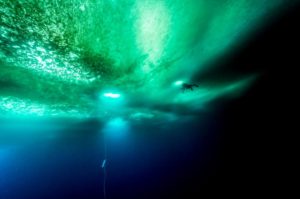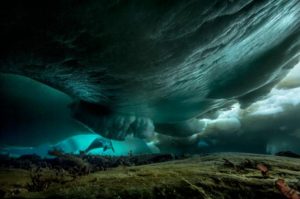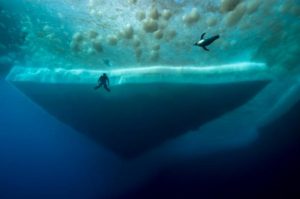Tags
Antarctica, Beyond the Cosmos, Christ, Christianity, Conservatism, Everlasting, Experience, Family, Fellowship of the Minds, Freedom, Genealogy, God, Lessons, Let Freedom Ring, Liberty, Life, Posterity, Teaching, United States, Wisdom
Share it
In the morning, when we arrive on foot from Dumont d’Urville, the French scientific base on the Adélie Coast of East Antarctica, we have to break up a thin layer of ice that has formed over the hole we drilled the day before. The hole goes right through the 10-foot-thick ice floe. It’s just wide enough for a man, and below it lies the sea. We’ve never tried to dive through such a small opening. I go first.

A diver swims beneath several feet of Antarctic ice. The rope hanging nearby helps divers find their way back to the surface.
The trip down for me to shimmy through the hole requires pushing, pulling, leveraging and straining with hands and the tips of my swim fins, knees, and heels. As I plunge at last into the icy water, I look back to a sickening sight, as the hole has already begun to close behind me.
I also notice that the underneath surface of the sea ice is covered with a thick slurry of floating ice crystals, and my descent has set them in motion. They’re converging on the hole as if it were an upside-down drain. By the time I thrust one arm into the icy mush, it’s three feet thick. Grabbing the safety rope, I pull myself up inch by inch, but my shoulders get stuck. Suddenly I’m stunned by a sharp blow to the head: Cédric Gentil, one of my dive buddies, is trying to dig me out, and his shovel has struck my skull. Finally a hand grabs mine and hauls me into the air. Today’s dive is over—but it’s only one of 32.
********************
At home in France we spent two years preparing. On a map of the Adélie Coast pinned to my wall, I chose dive sites that had a range of bottom depths and were within six miles or so of Dumont d’Urville. We worked with manufacturers to identify the weak points of classic diving suits. The water of Antarctica was going to be colder than 29 degrees Fahrenheit. (Salt water remains liquid below freshwater’s freezing point of 32 degrees.) Without dry suits we’d die in as little as 10 minutes. With our improved equipment we could last up to five hours.

A seal swims beneath sea ice near Dumont d’Urville Station.
The preparations for each day’s dive take just about as long. Where we can’t slide into holes left by Weddell seals and their busy teeth, we dig our own with an ice-drilling machine. Seals, when they need air, somehow find their way back to their hole; our greatest dread is getting lost and trapped under the ice. So we drop a luminescent yellow rope into the hole and pull it along with us during the dive. At the end we follow it back up.
Our suits have four layers: thermal underwear on the inside, followed by an electrically heated bodysuit, a thick fleece, and a half-inch-thick layer of waterproof neoprene. There’s a hood as well as an underhood, waterproof gloves and heated liners, fins, and 35 pounds of weights. There are two batteries for the heated bodysuit, a rebreather to remove carbon dioxide from our exhalations (allowing us to dive longer), backup gas cylinders, and finally, my photography equipment. We look like astronauts minus the bubble helmets. Just getting into our suits takes an hour and the help of Emmanuel Blanche, our emergency doctor.
********************

A diver watches an emperor penguin as it swims nearby.
At depths of 30 to 50 feet, forests of kelp, with blades more than 10 feet long, create a sober, imposing scene. Farther down, we meet giant sea stars: At 15 inches in diameter, they’re much bigger than those in warmer seas. Then come the giant Antarctica sea spiders, arthropods like insects and spiders on land, and they’re found in all the world’s oceans, but in warmer waters they’re rare and tiny, nearly invisible to the naked eye. Here, as in the Arctic, the sea spiders can span a foot or more. Yet their bodies are so small that their internal organs extend into their legs.
Below 165 feet, the light dims and we see no kelp or other plants. Instead, the seafloor is covered with thick carpets of feather hydroids (colonial animals related to corals) and with thousands of scallops. The scallops are four inches across but may be 40 years old or more—things grow slowly in Antarctica. At these depths we also notice feather star crinoids, close relatives of sea stars, which snag particles of drifting food with up to 20 undulating arms. Crawling and swimming among them are giant isopods that resemble beetles.
At 230 feet, the limit of our dives, the diversity is greatest. We see gorgonian sea fans, shellfish, soft corals, sponges, small fishes—the colors and exuberance are reminiscent of tropical coral reefs. The fixed invertebrates in particular are enormous. Well adapted to a stable environment, these plantlike animals grow slowly but, it appears, without limit—unless something disturbs them.
********************

A young Weddell seal…
After 36 days we felt we’d only begun to plumb Antarctica. The trip was so intense—the work so hard and exhausting, the sleep each night so deep—that in memory it seems to fuse into a single, 36-day-long dive. Our feet and hands froze, but our emotions were on a perpetual boil.
One dive toward the end stands out in my heart, not for the animals we saw but for the location. At home in France, looking at the Dumont d’Urville map, I had dreamed about it. Where, in this century on this Earth, can you be truly alone? Where can you see something no one has seen before? On the map I marked the Norsel reef, a tiny island more than seven miles offshore from Dumont d’Urville. In winter it’s icebound.
By the time our helicopter flew over it, Norsel was in the open sea, a spire of rock just piercing the surface of water more than 600 feet deep. It was topped with a little ice cap. When the chopper dropped us, we were surrounded by ocean and giant icebergs—and well aware of the privilege of being where nobody had ever dived.
Summer was coming, and it was a mild, almost balmy day, around freezing. But the water was still below 29°F. Blanche, the doctor, activated the chronometer: He gave us three hours and 40 minutes. Then we were off, for another soak in another world.
********************
For full National Geographic stunning excellence simply click on Logo … you will not be disappointed!

********************

Soli Deo Gloria!

 Link To DennisGHurst.com
Link To DennisGHurst.com


